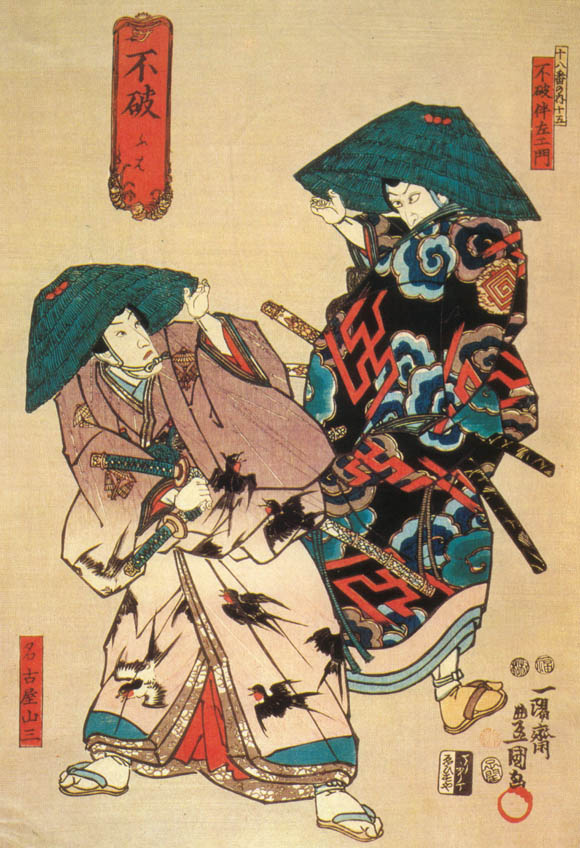| FUWA |
| Play titles | Yűjoron Daifukuch˘ Sankai Nagoya Fuwa |
||||||||||||
| Authors | Mimasuya Hy˘go (1697) Kawajiri Seitan (1933) |
||||||||||||
| History |
"Fuwa" was premiered in the 3rd lunar month of 1680 at the Ichimuraza, under the title "Yűjoron" [more details]. The first sayaate scene in Kabuki history was staged with Ichikawa Danjűr˘ I and Murayama Shir˘ji in the roles of Fuwa Banzaemon and Nagoya Sanzabur˘. In the 1st lunar month of 1697, it was added in Mimasuya Hy˘go's drama "Daifukuch˘ Sankai Nagoya", which was premiered at the Nakamuraza and which opened with the first bombastic "Shibaraku" scene in Kabuki history and ended with a spectacular scene with the Chinese Deity Sh˘ki Daijin. Tsuruya Nanboku IV revived the sayaate scene in its 1823 masterpiece Ukiyozuka Hiyoku no Inazuma. It became the independent drama "Sayaate", which is regularly staged nowadays. "Fuwa" was added to the Kabuki Jűhachiban collection of drama in 1840 by Ichikawa Ebiz˘ V. It was performed once by Ichikawa Sansh˘ V, with a new script written by Kawajiri Seitan and based on "Daifukuch˘ Sankai Nagoya". It was never performed by Ichikawa Danjűr˘ XI or Ichikawa Danjűr˘ XII. In modern times, it was revived twice as an independent drama and once with the revival of "Sankai Nagoya" at the National Theatre:
|
||||||||||||
| Key words |
Akamatsu Enshin Aragoto Fukaamigasa Fuwa-nagoyamono Kabuki Jűhachiban kamisuki Kanpaku Keisei Kuruwa Keiseikai Nakanoch˘ Nyűd˘ Sake Sayaate Sengi Yoshiwara Z˘ri Z˘riuchi |
||||||||||||
| Summary |
Introduction The nyűd˘ Akamatsu Enshin and Kajikawa Gunpei, two retainers of the Minister Kokuun [1], have plotted together against the kanpaku and the stealing of a sacred sword named Kumo-harai [2] was part of their conspiracy. An official inquiry (sengi) was started to retrieve the sword and, as part of this inquiry, the two warriors Nagoya Sanzabur˘ (commonly called Nagoya Sanza) and Fuwa Banzaemon Terumasa are aimlessly wandering around, all over the country, looking for clues or hints about the missing heirloom. Their peregrination have led them to the City of Edo. In Nakanoch˘ in Yoshiwara The two men, wearing a basket-hat hiding their face, a fukaamigasa, meet by chance in Nakanoch˘, the heart of the bustling pleasure quarter (kuruwa) of Yoshiwara [3]. Sanza has a close love relationship with Katsuragi, a Yoshiwara keisei belonging to the Kanbayashi house of assignation. Forgetting their common goal of retrieving the sacred sword, the jealous Banzaemon can't stand his rival anymore. They recognize each other when their sword scabbards touch (sayaate). The inevitable and spectacular quarrel blows up in front of the Yoshiwara crowd. Blood is about to get spilled and some heads are about to roll but the two angry men are stopped by Fujigae, the wife of Banzaemon, who rushes between them. After having checked the feeling of Katsuragi, it is clear that Banzaemon has the firm intention to help ransom her but he also intends having a good time with another courtesan (keiseikai). In Katsuragi's Room Katsuragi tells Banzaemon that she has already a husband. A short fight starts when Banzaemon answers that a keisei with a husband is only a thief stealing her customers. The fight ends with disheveled hair and it is followed by a hair-combing (kamisuki) romantic scene. Katsuragi also serves some sake to Banzaemon. The more he drinks sake, the more he falls in love for her. Sanza, who has watched everything, is definitely persuaded that it is time to act. He jumps into Katsuragi's room and the scene ends with a spectacular z˘riuchi, the humiliating beating of Banzaemon's head with Sanza's straw sandal (z˘ri). Summary edited by Marion Hudson |
||||||||||||
| Notes |
[1] We did some research but we have not found anything related to this Minister in Japan history. Kokuun literally means Black Cloud. [2] Literally the "Cloud Remover" sword. [3] In "Daifukuch˘ Sankai Nagoya", the scene was set in the pleasure quarter of Shimabara in Ky˘to, not in Edo. |
 |
|
The actors Ichikawa Danjűr˘ VIII and his father Ichikawa Ebiz˘ V playing the roles of Nagoya Sanza and Fuwa Banzaemon in the drama "Fuwa" (print made in 1852 by Utagawa Toyokuni III) |
|
|
| Contact | Main | Top | Updates | Actors | Plays | Playwrights | Programs | Links | FAQ | Glossary | Chronology | Illustrations | Prints | Characters | Derivatives | Theaters | Coming soon | News |